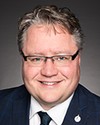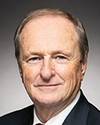Thank you, Chair.
Good afternoon, everyone. I appreciate your inviting me to be here today.
I would like to first introduce the Atlantic Groundfish Council to you. We represent year-round groundfish harvesters in Atlantic Canada. We are committed to a balanced, sustainable groundfish industry that puts the responsible management of the resource first and foremost. Whether they are based in Lunenburg, Nova Scotia, or Arnold's Cove, Newfoundland, our members believe the future of tomorrow is based on the decisions made today.
Our members have been part of the groundfish fishery for generations and are deeply passionate about its future. These are family-owned and indigenous-owned local companies. Collectively, AGC members employ thousands of Atlantic Canadians in primarily year-round jobs, with an annual payroll for local employees exceeding $200 million. They spend another $400 million on goods and services from local businesses annually and donate millions to community organizations and charities every year. They provide quality employment opportunities, and those employees are often the heart of rural communities, serving as volunteer firefighters, coaches of youth sports teams, breakfast program volunteers and the lifeline of many clubs and organizations. AGC members provide economic stability in coastal communities, which often have limited alternative access to economic opportunities.
In terms of the redfish history, the unit 1 redfish fishery is not a new fishery, neither in policy nor in practice. An ongoing fishery has been conducted at a reduced level, according to DFO-defined proportionate quota shares, for many years. The offshore sector, which owns and fishes from small, medium and large boats and operates coastal production plants, developed the commercial redfish fishery. Its historical quota share of gulf redfish was 78.7%.
Stability of quota shares is a key piece for us. Long-established quota-sharing arrangements are the foundation of responsible, transparent fisheries management in Canada and are firmly entrenched in current public policy, including for reopening closed fisheries: “Where closed fisheries are reopened, the Minister...will generally respect historic fleet shares, reflecting past participation in and dependency on a particular fishery as the basis for allocations.”
Stable quota shares enable right-sizing harvesting capacity to the resource; help fishers make long-term plans with confidence; promote a conservation ethic to harvest for tomorrow; promote self-reliance; protect investments made in good faith, including by indigenous groups; facilitate better-quality products and economic efficiencies; and provide transparent decision-making. I would note that at the international negotiating table, Canada's position on reopening closed fisheries is clear: to respect existing quota shares.
In terms of the decision made by the minister earlier this year, although AGC members have been painted by some as a winner in the decision, these local companies lost 20% of their share and feel that loss deeply. That includes indigenous licence-holders from seven Mi'kmaq communities in Nova Scotia and Newfoundland and Labrador through their 50% ownership of Clearwater Seafoods. These businesses have reinvested tens of millions of dollars in the redfish fishery. They have continuously participated in good faith in the commercial, index and experimental fisheries since their development, going back to the 1950s, based on government's sharing arrangement policy.
Looking forward, we respect the government's goals of increased indigenous participation in fisheries and continually express our willingness to help reach those goals. We've also chosen to accept that an almost doubling of quotas for inshore harvesters in Newfoundland, Nova Scotia and Quebec comes at our expense.
The rebounded redfish stock in the gulf presents a real opportunity for people and communities throughout Atlantic Canada and Quebec, but in a highly competitive global market, industry needs to be equal parts realistic about the opportunity and focused on achieving it together. The task for industry is to harvest, process and market the right-sized redfish to the right markets, in the right product form, at the right time of year. The more successful industry is at achieving that, the better news for everyone.
We have a lot to offer the industry as we move closer to the opening of a commercial redfish fishery. We are familiar with existing and developing markets. We are continuously willing to invest in marketing and sustainability requirements. We have experience harvesting quality redfish in a fleet of vessels that vary in size from 61 feet to 245 feet. Our processing experience is held by local employees, and we already hold MSC sustainability certifications for five groundfish species in Atlantic Canada, with another five under fishery improvement projects that secure access to many markets.
Those efforts borne by the AGC and its members benefit harvesters from all fleet sectors who fish those species.
Thank you.








